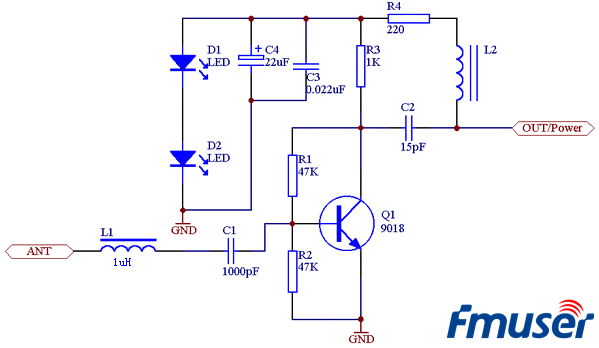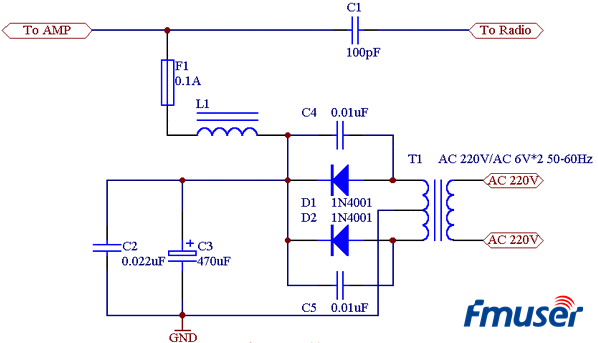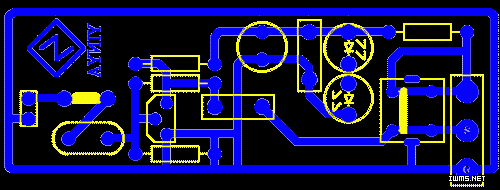The method of making this amplifier is very simple, but if you test it, you will find it useful. In this article. Usually, if you have reception problems, the picture will break up or freeze on your digital TV. Unlike analogue TV, it won’t look snowy or fuzzy. In fact, a weak TV signal can still show up clear but then cut in and out. If that’s happening to you, it’s most likely a reception problem. Fmuser will help you to assemble an amplifier. If you don’t want to assemble it yourself, you can also have it right away by clicking here.
1. What is antenna amplifier?
In electronics, an antenna amplifier (also: aerial amplifier (booster), Am antennefier) is a device that amplifies an antenna signal, usually into an output with the same impedance as the input impedance. Typically 75 ohm for coaxial cable and 300 ohm for twin-lead cable.

An antenna amplifier boosts a radio signal considerably for devices that receive radio waves. Many devices have an RF amplifier stage in their circuitry, that amplifies the antenna signal, these include, but are not limited to; radios, televisions, mobile phones and Wi-Fi and Bluetooth devices. Amplifiers amplify everything, both the desired signal present at the antenna, and the noise. Typical signal noises include: ambient background noise (electric brush noise from electric motors, high voltage sources from, for example a gasoline engine ignition, or large dispersed currents in the vicinity of the desired reception electric fence). To add, consideration must be taken for the noise generated by the amplifier itself and all other electrical noise which may be generated by the device that is to receive a signal, for example a lot of consideration has to go into mobile phone circuitry design to eliminate as much noise from its own circuitry in order to not disturb the desired transmission signals from its own antenna(ae).
An indoor antenna may include an amplifier circuit, whereby powered reception of the signal can help with capturing as much of an FM, UHF/VHF signal, for amplifying a radio or television signal. Its draw backs are that any noise is usually amplified as well, and a common result from this is amplification of ghost images (for analog signals), and any other perturberances that may be existing locally or even extra terrestrially like the Cosmic microwave background radiation for devices that work in that frequency range.
Through the video below, you should have a better understanding of the antenna amplifier:
2. how to make an antenna amplifier?
Figure 1
Figure 2
From the circuit diagram, we can see that this amplifier is the outdoor type. Figure 1 is the amp's main line installed outdoors; Figure 2 is the indoor power line box. Indoor and outdoor connect via 50 ohm or 75 ohm coaxial cable.
Now let's have a brief talk about how to make it.
Figure 3
Figure 4
Figure 3 is the main circuit board, and the actual size is 6.4 cm × 2.4 cm; Figure 4 is a circuit board power supply box, and the actual size of 5.1 cm × 3.1 cm.
The circuit board is handled as shown in the figure, followed by selecting components: circuit in Figure 1, L1 with the color code 1uH inductance; resistance and capacitance values selected according to the diagram, transistor low noise high quality ultra-high-frequency control, in addition to the figure of 9018 , you can also use 9016,1359 and so on; L2 winding with waste in the week, the week of the original wire diameter with the same number of laps for the 300 laps; D1, D2 is light, but also for regulators to use. Figure 2 circuit in Figure 1 in the L1 with the L2 as the production, use 100mA fuse on it, with the other components are the same as in Figure 1, click the image selection.
There is no problem as long as the selection of components, welding is completed, the amplifier that can work.
3. Functions of antenna amplifier
It is typical for any signal to lose some signal strengths and quality as they travel in the atmosphere. And along the way encounters and pick up some noise, which all together will degrade the original signal quality. That by the time it reaches the receiving antennas, the signals have already been deteriorated, attenuated to a point that is way below the minimum sensitivity thresholds of any TV receivers.
In order for a communications receiver (such as a TV) to receive a signal, it must be able to recognize that there is a signal it can understand, and it must be able to separate that signal from other signals, which are “noise”. If the signal is to weak for the receiver to decode, you must add “gain” to offset the losses that the signal has incurred by travelling through space from the transmitter to the receiver. Such gain can be attained from a directional antenna or from an amplifier inserted btween the antenna and the receiver circuit. Antenna gain results from increased directionality. It makes the desired signal stronger AND screens out undesired signals (noise) from different directions.
Amplifier gain makes the desired signal stronger AND it makes the noise stronger as well. The performance of the receiver depends on the desired signal’s strength AND on how much stronger that signal is above the “noise floor”. If the reason for poor reception is weak signal strength, an amplifier will help you. If the reason is poor signal/noise ratio, it will NOT help you.
4. How does an antenna amplifier work?
An amplifier is powered by the antenna cable that runs from a 240-volt plug near or at the back of your TV. When your antenna picks up a weak signal, your amplifier will boost, repeat, or amplify this signal to make it clearer and help transfer the data to your TV. That way, your TV can get a signal that’s strong enough for it to work, even if your antenna isn’t able to pick up a strong enough local signal directly.
Anyone can buy an FM antenna and start their own radio station. All one needs is the right equipment and, of course an FCC license, which is not to terribly difficult to obtain. If you have ever dreamed of owning your own radio station, it is as easy as finding an FM broadcast equipment distributor that specializes in antenna sales for radio broadcasting. FMUSER can make your dream come true. We specialize in radio broadcasting equipment, and we even help our customers obtain their FCC license if needed. We can even help you build your radio station. We have the lowest prices on all of the equipment you need for your radio broadcast. Contact Fmuser today!
If you would like to build a FM radio/TV station or buy any FM/TV broadcasting equipment, please feel free to contact us.
Contact: Sky Blue
Cellphone: +8615915959450
WhatsApp: +8615915959450
WeChat: +8615915959450
Skype: sky198710021
E-mail: [email protected]
You May Also Like:
Our other product:




















